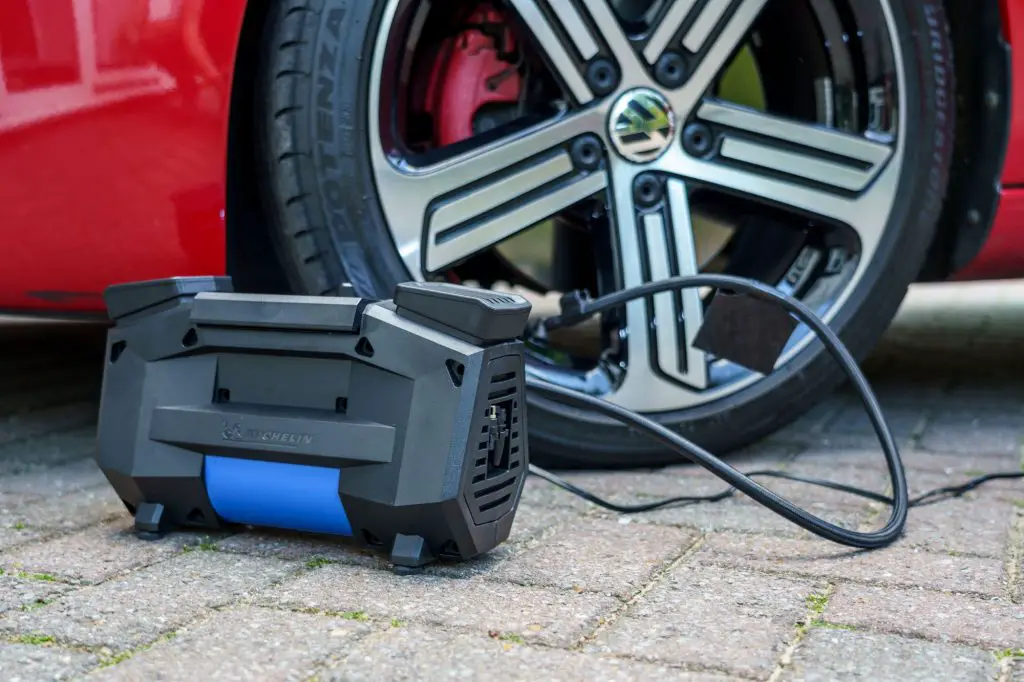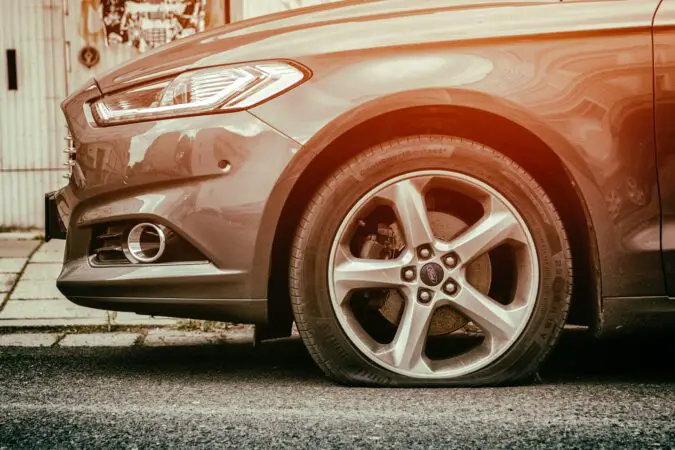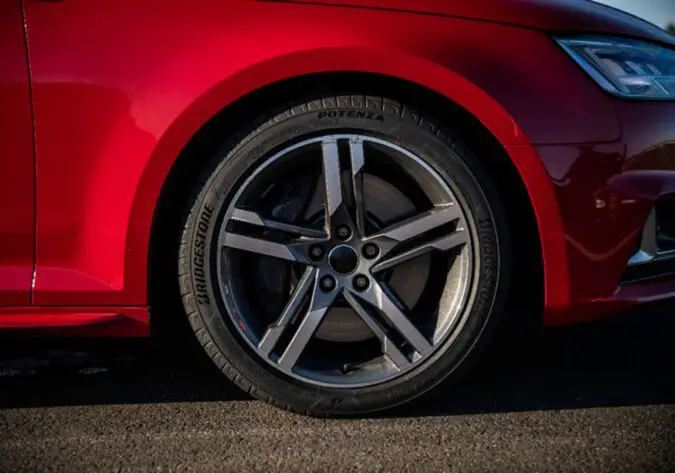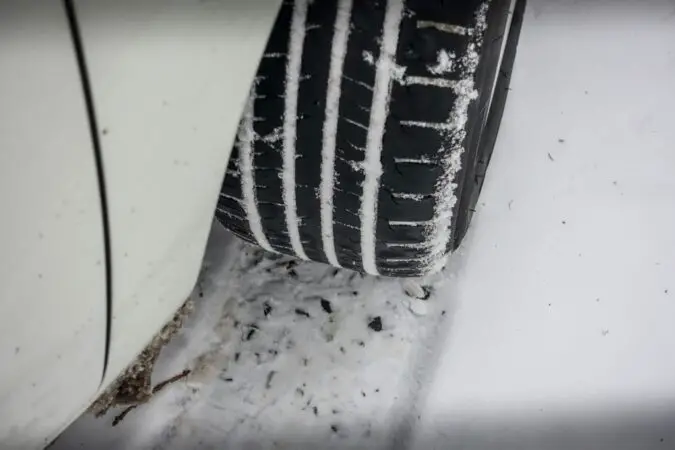Maintaining the proper tire inflation pressure is crucial for maximizing tire performance and fuel efficiency. Both overinflated and underinflated tires can cause problems. According to the National Highway Traffic Safety Administration, one of the significant causes of tire failure is actually driving with under-inflated tires.
Tire pressure may seem like an insignificant matter and perhaps something you don’t have time to worry about. But it actually has a big impact on how well and how safely your car performs. One of the simplest ways to keep your tires in good condition is to check your tire pressure once a month.
Additionally, it can help your tires wear evenly over time, which can save you money. You can guarantee that your tires will last longer if you keep them inflated properly. On the other hand, incorrect tire inflation can cause rapid or irregular wear, significant internal tire damage, and unexpected tire failure. This can even result in life-threatening injuries.
- Tire Pressure
- Minimum And Maximum Tire Pressure
- Check Tire Pressure
- Overinflated And Underinflated Tires
- Steps To Fill Up Tires
- Cold vs Hot Tire Pressure
- Final Conclusion
- FAQs
Tire Pressure
In order to maintain the proper shape and stiffness to transport a vehicle along the road, a tire holds air inside it. The pound per square inch, or psi, is the unit of measurement for the volume of air in a tire. The contact patch, or area of the tire that actually touches the ground, is where this number originates.
A fully inflated tire will appear practically round, whereas an under-inflated tire will look flatter. For the contact patch to be the proper size, a specific amount of tire pressure must be maintained. An under or over-inflated tire is more vulnerable to damage. Additionally, it makes the vehicle less stable as it is moving.
To extend the life and wear of tires, proper maintenance and maintaining the correct tire pressure are necessary. Overinflated tires have greater tread wear in the middle, whereas underinflated tires have more tread wear along the edges. Worn areas are more prone to picking up or being punctured by sharp items (such as driving with a nail in the tire) when you run over them.
Normal Tire Pressure
For the best gas mileage and the longest tire life, it’s crucial to maintain the correct tire pressure. The recommended tire pressure (you can find out more in our guide for tire pressure for Honda CRV and the Tesla Model 3 tire pressure) for your automobile is printed right on the door of the vehicle.
This exact figure will provide the best handling, gas mileage, and tire life for that particular car. When filling them with air to the advised pressure, expressed in pounds per square inch, or psi, that is the one you should adhere to. The appropriate tire pressure is typically listed on a label inside the driver’s door of newer vehicles.
If there isn’t a sticker on the door, in most cases, the owner’s manual contains the specifications. The majority of passenger cars advise an average tire pressure of 32 to 35 psi in the tires when the tires are cold.
The reason you should check tire pressure when the tires are cold is that as tires roll along the ground, heat is produced through contact with the ground, raising both tire temperature and air pressure. Make sure the car has been sitting overnight or at least for a few hours to get the most precise reading (not to mention the most reliable).
Correct Tire Pressure
The tire pressure set by your car’s manufacturer as the ideal air pressure for your tires is known as the recommended tire pressure. Running your tires at the proper pressure keeps you safe, lowers your gas costs, and extends the life of your tires.
Tire Inflation: Minimum Tire Pressure
The majority of manufacturers don’t actually specify a minimum tire pressure. Functionally, the optimal number is also the minimum since the suggested value is the minimal quantity of air a tire must have in order for a car to handle correctly and safely. Anything less than that value is not advised.
Vehicles must be equipped with tire pressure monitoring systems (i.e. TPMS sensor) – aka the tire pressure ‘TP’ sensor – in accordance with U.S. legislation. These alert the driver when the tire pressure drops below 25% of the recommended psi.
Unless, of course, your car experiences a tire pressure sensor fault or require a tire pressure sensor replacement or a tire sensor replacement. The latter might necessitate considering the cost to replace the tire sensor. While less extreme pressure dips are still regarded as moderate or mild under-inflation and can still have adverse effects, this condition is termed severe under-inflation.
Your car will not operate properly if your tires are inflated to a pressure that is lower than the recommended psi (as indicated in the manual or on the driver’s side doorjamb). Underinflation can result in tire overheating. This can cause the tread to separate from the tire body. This could result in a blowout and a serious accident if it occurs on the highway.
Make sure your tires are not under-inflated for financial and other reasons. A low tire has increased rolling resistance which means that the car must work more to travel down the highway and hence uses more fuel. You’ll save money at the gas pump if your tires are properly inflated.
Tire Inflation: Maximum Tire Pressure
Never fill your tires up to the recommended pressure on the tire. That number is the tire’s maximum allowable pressure, not the recommended pressure for the vehicle. Be careful not to mix the recommended pressure with the maximum pressure. You should fill your tires to the proper pressure, which, as previously said, can be found on your doorjamb or in your owner’s manual.
On the other hand, the maximum pressure is typically noted in small print close to the tire bead on the sidewall of the tire itself (where the rubber abuts the rim). This is the maximum pressure that a tire can safely withstand specified by the tire manufacturer rather than the vehicle manufacturer.
The maximum psi for your tires almost always exceeds the recommended pressure. For regular driving, it is not suggested to fill your tire to this pressure. At maximum psi, your car’s handling, braking, and risk of severe blowouts are all compromised.
Additionally, over-inflation can shorten the life of your tires by causing the tread in the middle of the tire to wear out too soon. This is in addition to other odd tire wear patterns, such as inner tire wear (also known as inside tire wear) – more on that later.
However, if you are towing or pulling a particularly big cargo, you might want to apply the maximum pressure on that occasion.
Check Tire Pressure
Tires lose around 1-3 lbs. psi of inflation pressure per month according to Fleet Equipment Magazine. Therefore it’s critical to check your tire pressure frequently. Make sure your car has been sitting for a few hours so that the tires are cold before checking the tire pressure.
We advise you to check your tire pressure at least once every month and whenever you’re preparing to go on a long drive. Check the pressure when the tires are cold first thing in the morning.
You’ll get the most accurate measurement while the tires are cold. Because heat from driving, rising air temperatures throughout the day, and even the heat of the sun shining on your tires can momentarily boost tire pressure.
A visual tire pressure check is never practical or accurate. It’s nearly impossible to determine a tire’s inflation level just by looking at it. Check the air pressure using good and reliable tire pressure gauges, as directed in the owner’s handbook or on the vehicle tire placard (often located on the driver’s side door jamb). If necessary, adjust the pressure.
Tire Inflation: Regular Inspection
You should also check for any indications of uneven wear in addition to visually inspecting it during your monthly inspection. The simplest approach to check for tire wear is to run your hands across the tread of the tire after moving from the outside to the inside of it.
It’s likely that you have an alignment or component-related problem if you experience any sharp edging or feathering across the tire. This brief examination can reveal whether a potential toe problem is present. When not adjusted properly, the toe setting, which directly affects tire wear, can significantly reduce tire mileage.
The usual rule of thumb is that the vehicle is toed out if both of the steer tires on the inside are worn (that should settle the issue of what causes tire wear on the inside), and toed in if both of the front tires on the outside are wearing.
Overinflated Tires
Overinflation of a car’s tires might result in a rough and uncomfortable ride. For this reason, you should avoid doing that too. Checking the tire psi at least once a month will help to ensure that all of your car’s tires are at the proper pressure.
Overinflated tires are rigid and unyielding, and they have a smaller footprint when they come into contact with the ground. When driving over potholes or other road debris, tires that are even 6 psi overinflated may be more easily damaged. Overinflated tires can ride harder since they can’t effectively isolate road imperfections.
Higher inflation pressures, however, often only increase steering response and cornering stability to a certain extent. Because of this, competitors using street tires in track events, and road races maintain greater inflation pressures than usual. Since the inflation pressure cannot be precisely predicted from eye inspection, the pressure must be checked with a reliable air gauge.
Underinflated Tires
It should go without saying that incorrect tire pressure in a car could have some catastrophic repercussions. For instance, driving with low tire pressure can reduce steering control and make maneuvering the car more challenging. So, it’s best not to test what does low tire pressure mean.
Additionally, it may cause the tires on your car to degrade more quickly, necessitating an earlier tire replacement. But more crucially, one of the main causes of most cars’ poor fuel efficiency is under-inflated tire pressure.
While in contact with the road, an underinflated tire is unable to keep its shape and becomes flatter than anticipated. Tire failure could result from a vehicle’s tires even while being only 6 psi underinflated. The tread life of the tire may also be decreased by up to 25%. The tire will be able to deflect (bend) more when inflated at a lower pressure.
As a result, internal heat will accumulate, rolling resistance will rise, and fuel efficiency could drop by up to 5%. Significant steering accuracy and cornering stability loss would result. While 6 psi might not seem like particularly low pressure, keep in mind that it typically corresponds to 20% of the tire’s recommended pressure.
Checking Tire Pressure
It is quite easy to maintain correct tire inflation, which is crucial for your car’s tires to function well overall. In comparison to a poorly inflated tire, a properly inflated tire offers a longer life, quicker steering response, higher fuel efficiency, and a smoother ride. Both under and over-inflation can result in problems such as early tread deterioration and potential tire failure.
Checking your tire pressure once a month is the best method to make sure you’re getting the most out of your tires. It is quite easy to use a tire pressure gauge. Here’s how to check the pressure in them and refill your tires.
You can use a basic or digital tire pressure gauge. Both are usually available in auto parts stores. Portable air compressors that are powered by your car battery or a 12-volt power outlet are available at many auto parts stores. You can also use the air compressor that is typically located at gas stations. The typical usage fee is $0.50 or $1.00.
How To Fix Tire Pressure
Tire Inflation – Step 1. Ensure That The Tires Are Cooled Down
Manufacturers of cars define psi, or “pounds per square inch,” of tire pressure, with the assumption that the tires are cold. After three hours or more of parking or after less than a mile of moderately rapid driving, tires are deemed to be cold. The data from your pressure gauge are expressed in psi.
Tire Inflation – Step 2. Check The Manufacturer’s Recommended PSI
To get the suggested cold tire psi for your front and rear tires, check the driver’s side door jamb or your owner’s handbook. Consult your car’s dealer, the manufacturer, or a certified tire expert if you can’t find it.
Your front and rear tires may need different pressure levels. To minimize confusion as you travel around your car monitoring tire pressure, write down the proper psi for each.
Tire Inflation – Step 3. Check Tire Pressure With The Gauge
Take off one of your tires’ valve caps. After that, set the pressure gauge on the valve stem and apply sufficient pressure such that the gauge reads and the hissing sound stops.
With a typical gauge, air pressure will cause a little bar to emerge from the gauge’s base. The bar has measurement units carved into it. The reading will be shown on a screen in a digital gauge. This technique should be repeated for each of the four tires. Note each reading.
Tire Inflation – Step 4. Fill Up Till The Recommended PSI
Any tire with low pressure should be inflated using an air compressor. Since many air compressors differ from one another, attentively reading the instructions can help you use them properly.
To ensure that the hose can reach all four tires while using an air compressor at a gas station, park carefully. Till you hear the motor running, put change into the machine. By positioning the hose end over the valve stem and pulling the lever, you may fill each tire.
Your tires may be “hot” if you use an air compressor from a gas station. If the tires’ inflation pressure needs to be changed while they are hot, raise it by 4 psi from the suggested cold inflation pressure. When the tires are cool, check the inflation pressure once more.
Utilize the gauge to recheck tire pressure after filling them. You can always let some air back out if you overinflated the tires at this stage. Never drive with tires that are too inflated. Reduced traction, premature wear, and reduced impact absorption can all be caused by overinflation.
Cold vs Hot Tire Pressure
If you paid attention in physics class, you would have learned that a gas’s pressure and volume can only remain stable in a closed system for as long as its temperature is constant. This is a crucial element to remember because the tire of a car is a closed system that contains gas.
This also implies that the inflation pressure of the tire will change in response to changes in operating temperature. As a general guideline, you can anticipate a pressure shift of one psi for every 10 degrees Fahrenheit change in the temperature of the tire’s air chamber.
Your car can start warning you that your tire pressure is low once the temperature cools. This is because tire pressure is affected by the outside temperature. The air in your tires expands more in hot weather and contracts more in cold weather, depending on the temperature. The computer in your car, therefore, thinks that your tires are low on air when the temperature drops.
For every 10 degrees that the temperature drops, the inflation pressure in tires typically decreases by 1 to 2 psi. Additionally, during the first 15 to 20 minutes of driving, the pressure in the tires will rise by one psi every five minutes as the vehicle warms up.
The recommended psi set out by tire manufacturers establishes the ideal tire pressure for your car. That value, though, is intended to be used when your tires are cool.
Summer Tire Pressure
Summer is a fantastic season to travel and explore on highways or on dirt roads. Have fun with your loved ones, but if your car’s tires are under-inflated, you won’t go very far. The summer’s rising temperatures may also have an impact on your car’s tire pressure.
For a safer, more effective, and enjoyable road trip, make sure your tires are inflated properly. What tire pressure is therefore ideal for the summer? The optimal pressure in your tires should remain constant year-round. But if you reside in a region with significant temperature variation, you must make necessary adjustments.
Your tire pressure is impacted by high temperatures. Your tire will lose or gain 1 psi for every 10 degree Fahrenheit increase or decrease. Theoretically, if the temperature rises by 20°F throughout the day which is a genuine possibility in many parts of the country, your tires could gain 2 psi.
Just take a look at Texas’ typical temperatures. According to Weather.com, May’s average high is around 80°F and lows are often in the 60s. As you travel a bit north and west, the weather becomes a little cooler, with average highs in the 70s and lows in the 50s from North Carolina to Kansas.
Your car is likely to experience natural factors that cause your tire pressure to fluctuate throughout the day, from the Virginian hills to the Oklahoman plains. So what should you do to manage the tire pressure in your car in the summer?
Keep your tire pressure at the psi level advised by your car’s manufacturer during the summer. The pressure in your tires may need to be decreased during the summer rather than increased. But you should always check that it is the correct psi for your vehicle.
Winter Tire Pressure
Contrary to popular belief, filling your tires up is more complicated than one may imagine. For instance, when it’s cold outside, the air in vehicle tires tends to take up less space than when it’s hot outside. Car owners should educate themselves on the differences between cold and warm tire pressure due to this variation in volume pressure.
To make sure that the tire pressure is constantly at an ideal level, regardless of the weather, it is essential to become familiar with the tire pressure and the differences between cold and warm tire pressure.
It’s also crucial to remember that as the temperature drops, a car tire’s inflation pressure tends to decrease. For instance, it is typical for car owners to notice a 1-2 psi decline in tire pressure for every 10°F drop in temperature.
Ideally, when you fill up your tires in the winter, you should do it while they are still chilly. However, you would likely need to travel to a gas station first, as the majority of people don’t have a method to inflate them at home.
So, make a note of the tire pressure for each tire before you leave the house. Measure the tires once more when you get to the gas station, and then add the necessary amount of pressure depending on the initial reading.
Tire Inflation: Conclusion
Proper tire inflation attributes to better fuel economy, improved handling and safety, more responsive braking, and a smoother ride. Tires operate best when they are inflated to the prescribed tire pressure for the vehicle, even though they are intended to withstand some temperature and psi variation.
The easiest approach to make sure your tires never fall significantly below the ideal psi is to regularly check your tire pressure. Make the aforementioned process a monthly ritual. You won’t be uncertain about the proper tire pressure again after reading this article, and you’ll know how to check it. You should be aware of everything related to the tire pressure recommendations for your car.
FAQs On Tire Inflation
How To Check Tire Pressure
Remove the cap covering the tire’s air valve, and store it safely away. For a few seconds, firmly press the tire gauge against the exposed valve stem. Check the air pressure gauge. Compare this value to the tire pressure that is advised. Replace the air valve cap on the tire.
How To Put Air In Tires
Find an air dispenser, and park so that the hose can reach all four tires. Remove the valve cap from the first tire’s valve. Connect the line to the valve and depress the valve and you will hear the tire being inflated. Continue filling the air and check the gauge in between till your tires attain the recommended psi of tire pressure.
What Should My Tire Pressure Be
Optimal tire pressure varies from vehicle to vehicle. However, for the majority of types and models, it is between 30-35 PSI. To avoid poor braking and shorter tire life, don’t over-inflate your tires to the maximum pressure or higher.
What Does Psi Mean
PSI means pounds per square inch. The Imperial system of measurement uses pounds per square inch (PSI) to measure pressure. PSI is frequently used to calculate the pressure of gases (pneumatic pressure) or liquids (hydraulic pressure).
What Tire Pressure Is Too Low
The lowest tire pressure you can use while driving is 20 psi, though even that is not advised. Driving on a tire that has less than 20 psi of air pressure is considered super dangerous for your car. You should add air if your tires are this low. Tire pressure recommendations typically range from 32 to 35 psi.
Where Can I Get Air In My Tires
Air dispensers are commonplace in gas stations. For safety concerns, it is usually placed apart from the gas pumps. Find a station, and park so that the hose can reach all four tires close to one of the dispensers.
What Should Your Tire Pressure Be In The Summer
During the summer, keep your tire pressure at the PSI level advised by your car’s manufacturer. The pressure in your tires may need to be decreased during the summer rather than increased. But you should always check that it is the correct PSI for your vehicle.
Is 40 Psi Good Tire Pressure
Sports cars or some high-performance passenger cars may be suitable with a pressure level of 40 psi. However, this is too low for heavy trucks and too high compared to the recommended pressure for small cars. However, the recommended pressure range for tires on well-known sports cars and some luxury passenger vehicles is 32 to 40 psi.
Where To Put Air In Tire
Locate the little rubber or metal valve stem along the inside rim of your wheel and unscrew it to access the air valve. Press the pump’s tip against the air valve’s tip while extending the air hose to the tire. Hold it firmly and steadily where it is while you listen to the tire filling with air.




